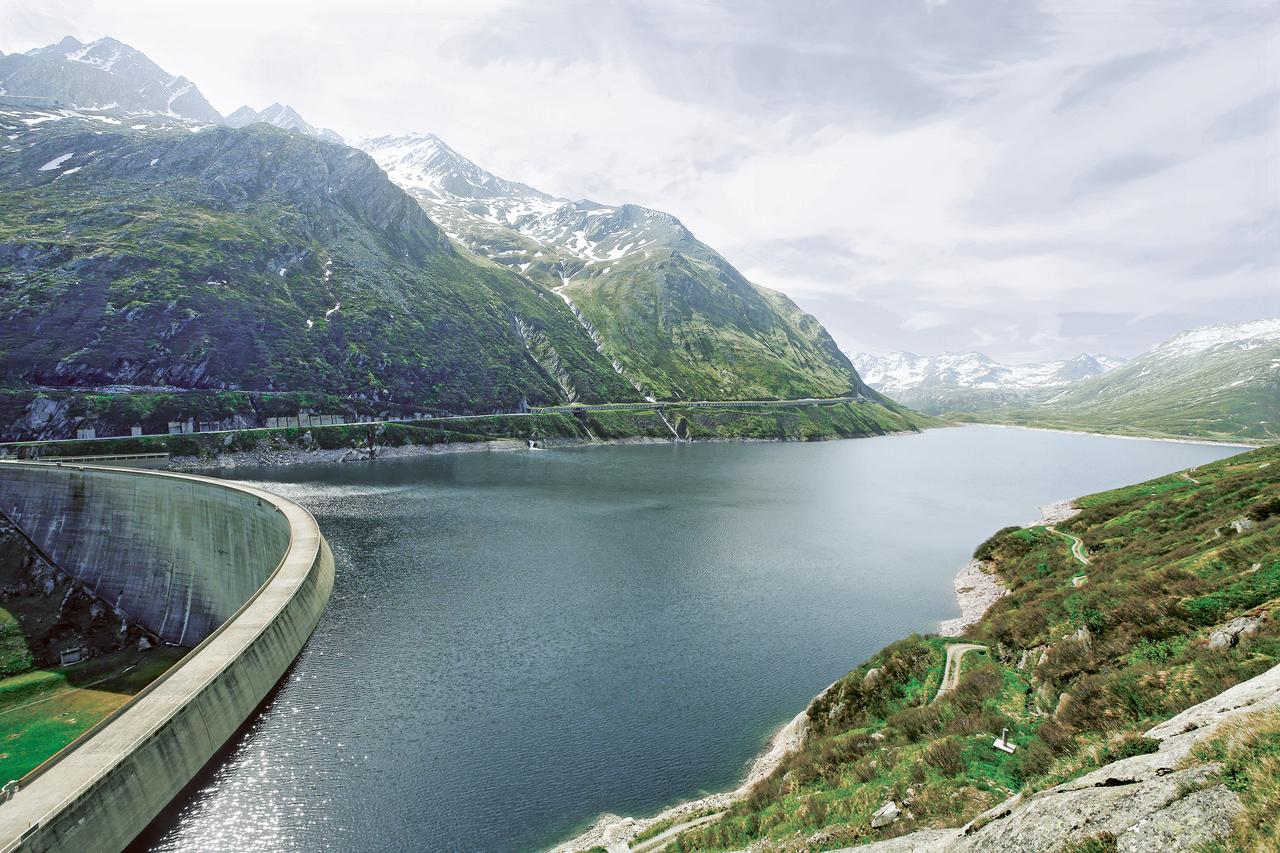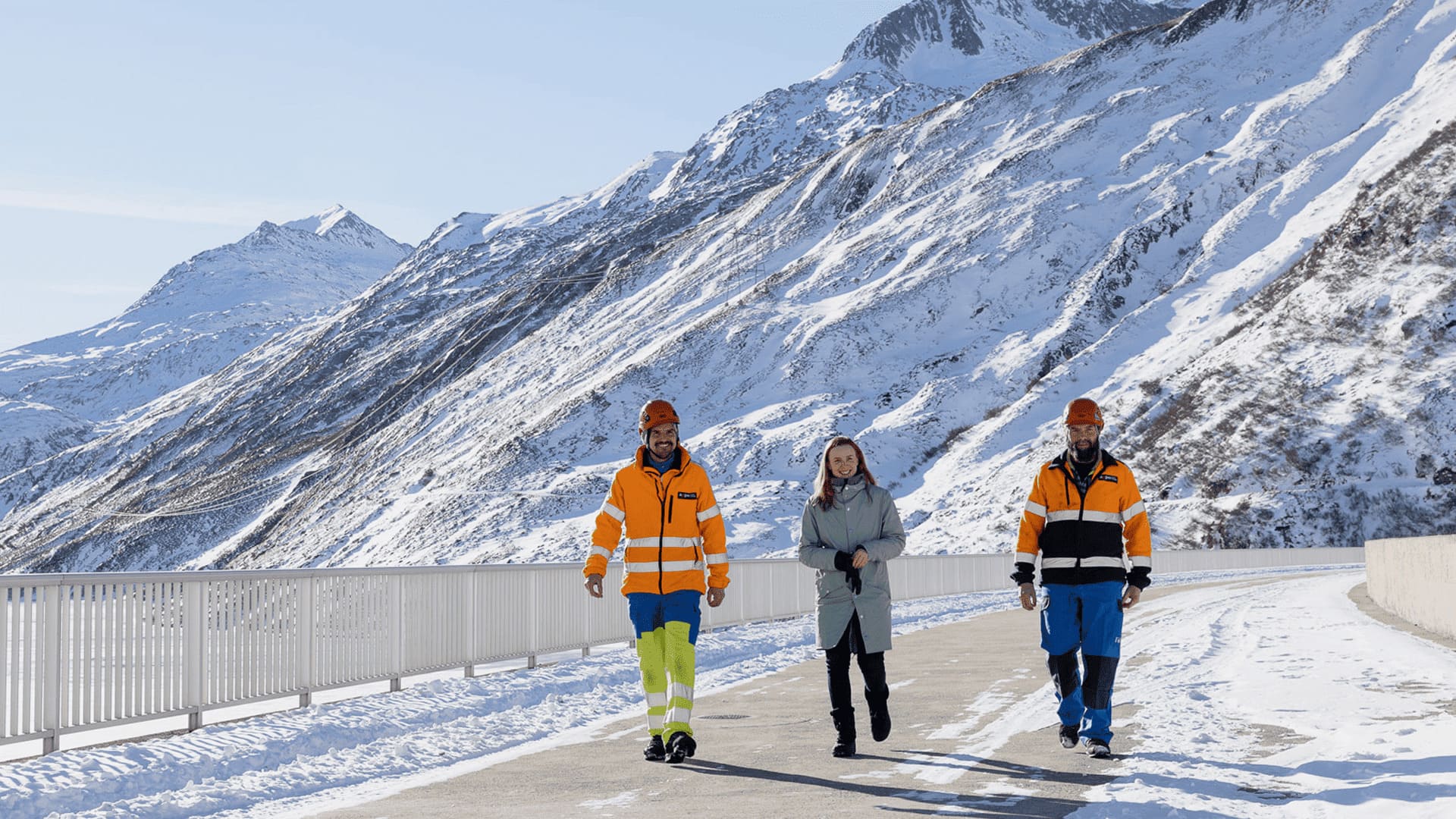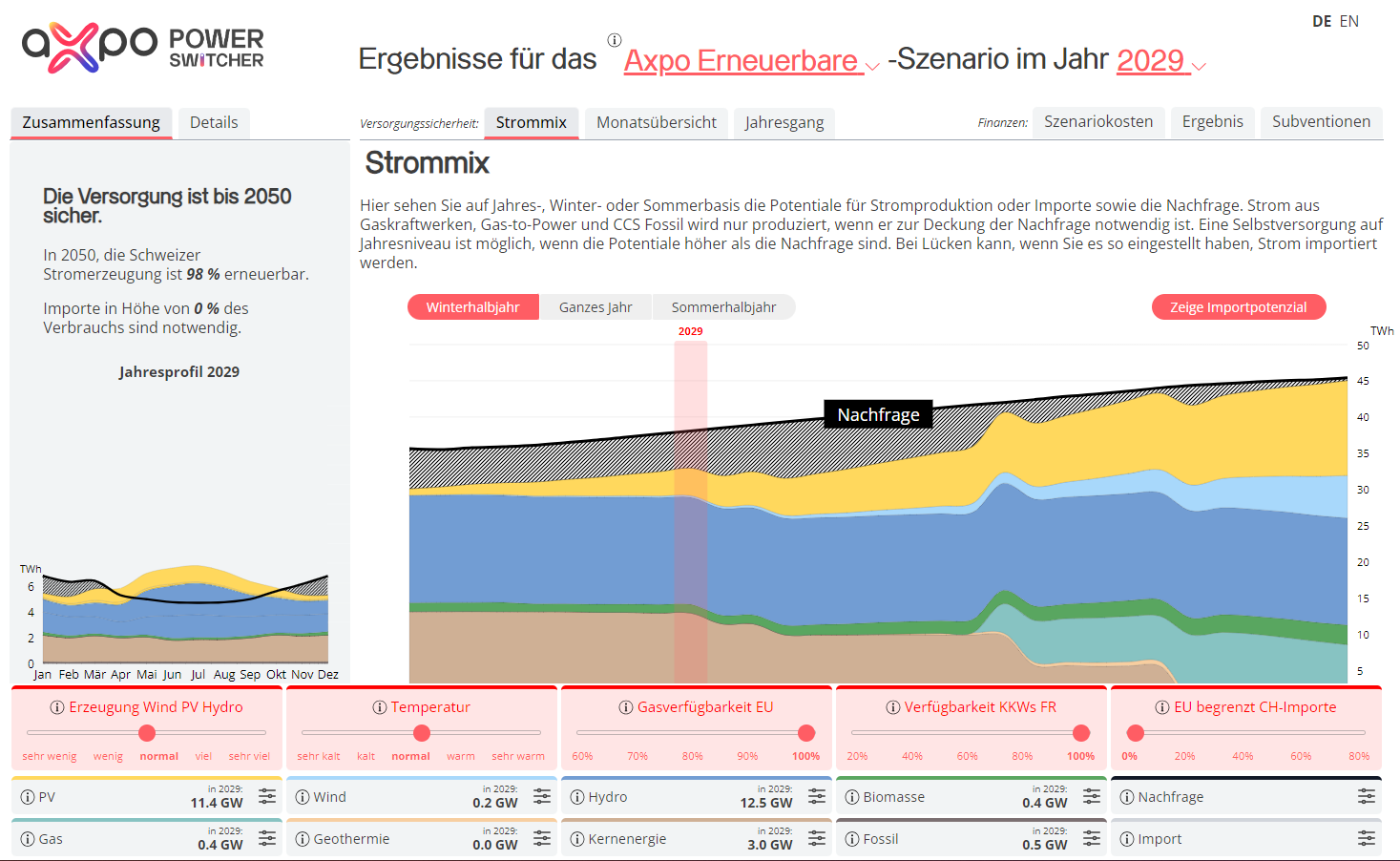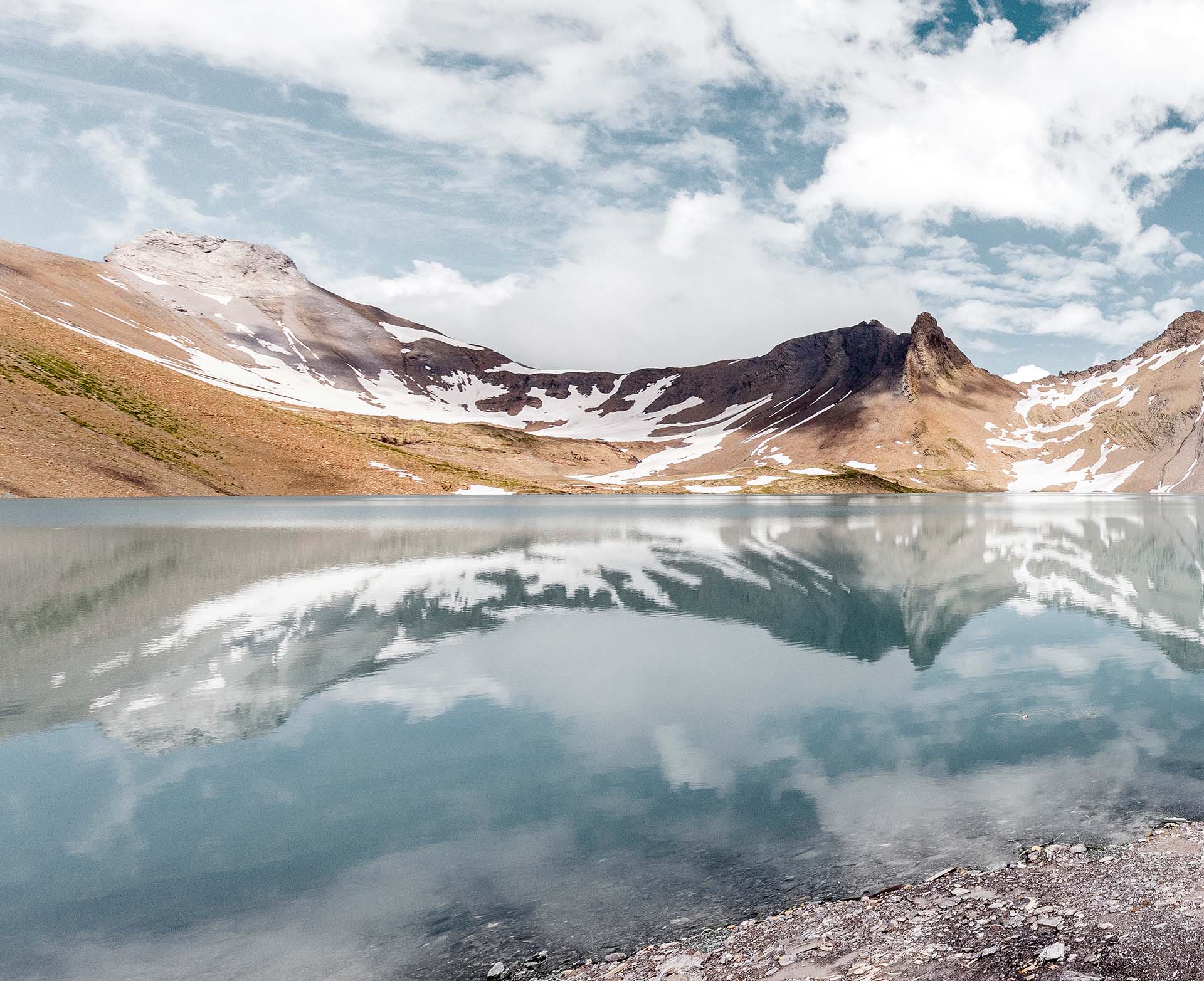Power Switcher Make your own electricity mix
Switzerland has to decide what it wants its future electricity supply to look like. This means establishing which mix of technologies will best fulfil the mammoth task of climate transition, how to expand the chosen energy sources to the required scope, and what costs might arise in the process. It must also come up with an optimal balance for the energy trilemma: climate friendliness, security of supply and affordability.
Axpo’s Power Switcher is an innovative instrument for modelling the electricity mix of the future, taking dependencies and costs into account. Anyone can use the electricity calculator to develop their own fact-based scenarios and find out more about the scenarios proposed by other people and organisations.
At Axpo, we have developed two of our own scenarios. Although very different, both pursue the goal of secure, climate-friendly electricity supply while keeping dependency on winter electricity imports as low as possible.
Our two scenarios Renewable and Landscape are described below. Each provides an answer to the question: what will our electricity mix look like in winter 2050?
The “Renewable” scenario
The “Renewable” scenario continues along Switzerland’s current trajectory within the existing Energy Strategy 2050 framework, while assuming a significant expansion of all renewable energies. It consists of a balanced mix of different technologies.
The scenario explained
Given its great potential, this scenario assumes that photovoltaics (PV) will supply around 24% of consumption in winter 2050 (full year: 40%), the largest share after hydropower. It’s important to distinguish between three types of PV: ground-mounted large-scale installations on dedicated land, panels installed on the roofs of commercial and private buildings, and Alpine installations high above the fog. These types differ substantially in terms of their technical properties (e.g. yield, full capacity hours) and costs.
Ground-mounted PV installations on the Swiss Plateau are a cost-effective form of electricity production. However, given the significant regulatory hurdles still in place, this scenario assumes an output of approximately 0.4 TWh for this type of PV in winter 2050 (full year: 1.5 TWh or almost 2% of consumption).
Panels installed on commercial and private roofs are the most widely accepted form of renewable energy, and still offer plenty of untapped potential. This type of PV will supply around 10.3 TWh, or 23% of Switzerland’s consumption in winter 2050 (full year: 33 TWh/37%).
In winter months, PV plants installed in the Alps high above the fog produce three times the electricity of comparable installations on the Swiss Plateau. Alpine PV will supply around 0.8 TWh, or almost 1% of Swiss consumption in winter 2050 (full year: 0.4 TWh/1%). These plants will need around 7 km2 of some 20,000 km2 of Alpine terrain – less than 0.1%.
Already the backbone of Swiss electricity supply, hydropower will continue to be a central pillar in this scenario. In particular, the flexibility of hydropower storage is key to short-term balance and protects Switzerland from outages and shortages, which is very important in winter. However, the potential for expansion is limited and production in existing works could decline due to environmental restrictions. Overall, Switzerland’s target must be to keep the production of hydropower stable. It currently produces around 36 TWh net domestically per year. Around 38 TWh are expected for 2050, which corresponds to a good 42% of Switzerland's annual consumption in 2050. In winter, the country can produce 16 TWh.
Thanks to technological advances and an improved political framework, the potential for wind power in Switzerland is significantly higher than previously assumed. One major advantage of wind power is the electricity it contributes in winter – two-thirds of output is produced during the winter months. This makes it the ideal complement to PV and, in the interests of a secure electricity supply, this is an advantage that Switzerland should exploit.
Wind power currently produces around 0.2 TWh, but in this scenario, it will represent around 5.9 TWh, or almost 13% of consumption in winter 2050 (full year: 10 TWh/11%). This will require approximately 1,200 wind turbines. As at November 2023, there were 47 wind turbines in Switzerland.
A significant proportion of biowaste is already being used for electricity production. Using waste in this way results in a sustainable cycle. While it makes a smaller contribution to electricity production by volume, it’s still an important component of a stable, broad-based mix. In our ‘Renewable’ scenario, by 2050 biomass will represent about 2.7 TWh, or 6% of Switzerland’s winter consumption, up from a current value of 2.3 TWh (full year: 5 TWh/6%).
Geothermal energy has the advantage of being available all year. However, while this technology has particularly high potential for heat generation, it’s of limited use in electricity production. Various pilot projects are currently under way, including at Axpo. In our scenario we assume production of around 1 TWh in winter 2050 (full year: 2.1 TWh/2%).
The idea that Switzerland could produce all the electricity it needs is unrealistic. Switzerland has optimal connections with the European electricity grid, with electricity flowing in both directions.
In this scenario we assume that Switzerland will have entered into an electricity agreement with the EU – or at least corresponding bilateral agreements with neighbouring countries – and will therefore be integrated into the European electricity market by 2050. The scenario shows low imports of 0.4 TWh in January and 0.7 TWh in December 2050, while exports and imports are expected to be balanced during the remaining winter months. In summer, robust output from photovoltaic plants means Switzerland will have a surplus, with around 11 TWh in exports expected.
From a security of supply perspective, this seems to offer a satisfactory supply situation in winter. However, if cold conditions coincide with particularly low output of electricity from renewable sources (wind, sun and hydro), reserves will soon be depleted and imports of 5 TWh will be required to ensure security of supply.
The technologies described above are ideal components of the electricity mix, but we still don’t have a carbon-neutral form of production that can be deployed in the event of shortages in winter months. The last nuclear power plant will go offline in the 2040s, but, in line with current framework conditions (i.e. the ban on new nuclear power plants), the “Renewable” scenario assumes that no new nuclear power plants will be constructed.
In this scenario, gas-fired power stations running on low-carbon gas will be deployed in winter months starting in 2040, with a capacity of 2.4 GW. These production sites will compete with imports on price to meet Swiss demand. Gas-fired power stations can produce up to 10 TWh of electricity per year, and they guarantee security of supply, particularly in winter when production of electricity from renewable energies is low.
In this scenario, the average cost per megawatt hour generated is CHF 93. If we assume more moderate electricity price levels of 85 CHF/MWh, around 95% of the costs for new investments could be met by income on the electricity market. This should attract investors to build the required installations.
However, the remaining 5% cannot be met by the market; this is a classic example of a public good. PV installations on rooftops make up the majority of these uncovered costs. This is driven by the fact that costs for investment and operations, distributed across the lifespan of a PV rooftop installation, may exceed the potential income. This applies to smaller roof installations in particular, as they are comparatively expensive to install. Similarly, other PV installations, renewable gas-driven power plants and biomass power plants are also unable to cover 100% of their costs. By contrast, wind farms and hydropower plants can cover all their costs at an electricity price level of CHF 75/MWh.
Funding instruments may be required to create incentives for investors to establish installations where costs cannot be fully met through income.
In this scenario, we make certain assumptions about costs and the electricity price. Of course, very low or high electricity prices and costs can result in higher or lower uncovered costs.
The “Landscape” scenario
The “Landscape” scenario reflects the reality that renewable energy projects are often thwarted through objections or at the ballot box, or delayed by decades. Resistance is often justified with arguments focused on preserving untouched landscapes or promoting biodiversity. However, if our target is to have secure, climate-neutral electricity supply by 2050 with an acceptable level of imports, the only option from the current standpoint is new nuclear power plants. This scenario radically reduces interventions in the natural environment in favour of new nuclear power plants and PV on roofs and existing infrastructure.
The construction of new nuclear power plants is forbidden under Swiss law, so this scenario remains hypothetical. In addition, it does not account for the high economic and regulatory costs for investors. But even in this hypothetical case, there is a significant expansion of renewable energies – especially rooftop photovoltaics. That’s because realistically, the construction of new nuclear power plants would take more than 20 years, but the increasing demand for electricity would still have to be met in the meantime.
The scenario explained
To close the winter electricity gap, the “Landscape” scenario assumes an operational lifespan of 70 years for both the Gösgen and Leibstadt nuclear power plants, provided they can be operated safely, and Beznau will run in total 64 years in this scenario. It also allows for two new reactors with 1.3 GW output each, going online in 2047 and 2050 respectively. Since the decision to build new plants will need to be made as quickly as possible, these reactors would run on third-generation EPR technology, which is already available. In winter 2050, electricity from nuclear power will contribute 15.7 TWh, or around 35% of Switzerland’s consumption (full year: 29.6 TWh/34%).
Photovoltaics form another essential piece of the puzzle to close the winter electricity gap. To minimise disruption to the landscape, this scenario dispenses with ground-mounted PV installations, and includes only a handful of Alpine solar plants. Given their valuable contribution to winter electricity, reducing the number of solar installations in the mountains means depriving Switzerland of a key contribution to security of supply. Instead, this scenario sees PV installations almost exclusively on rooftops. While they supply significantly less winter electricity than Alpine plants, they enjoy broad public acceptance and don’t impact the landscape.
Limiting the winter import demand to around 6 TWh will require a massive expansion of rooftop PV installations. Allowing for expansion up to an output of around 32.5 GW in 2050 and annual production of around 31 TWh, this scenario accounts for around 60% of the Swiss Federal Office of Energy’s estimated potential.
Installed capacity of solar power, 2050: 32.5 GW
- of which rooftops: 32.3 GW
- of which Alpine: 0.2 GW
- of which ground-mounted: 0 GW
Production, winter 2050: 9.7 TWh
- of which rooftops: 9.6 TWh
- of which Alpine: 0.1 TWh
Production, full year 2050: 31.2 TWh
- of which rooftops: 30.9 TWh
- of which Alpine: 0.3 TWh
If the ambitious expansion target for rooftop PV can’t be met, more fossil-based gas-fired power plants will need to be built to prevent a supply gap in winter.
Already the backbone of Swiss electricity supply, hydropower will remain a central pillar in the “Landscape” scenario. In particular, the flexibility of hydropower storage is key to short-term balance and protects Switzerland from outages and shortages, which is very important in winter. However, the potential for expansion is limited and production in existing works could decline due to environmental restrictions. Overall, Switzerland’s target must be to keep the production of hydropower stable. It currently produces around 36 TWh net domestically per year. Around 38 TWh are expected for 2050, which corresponds to a good 42% of Switzerland's annual consumption in 2050. In winter, the country can produce 16 TWh.
As parts of society are vehemently opposed to wind farms, this energy source barely figures in the “Landscape” scenario – although it could produce large volumes of electricity, especially in winter. In this scenario, in 2050 Switzerland will have just 80 wind turbines – less than twice the amount we have today(47). In winter 2050, electricity from wind power will contribute just 0.2 TWh, or around 0.5% of consumption (full year: 0.4 TWh/0.4%).
The idea that Switzerland could produce all the electricity it needs is unrealistic. Switzerland has optimal connections with the European electricity grid, with electricity flowing in both directions.
This scenario also assumes that Switzerland will have entered into an electricity agreement with the EU – or at least corresponding bilateral agreements with neighbouring countries – and that it will therefore be integrated into the European electricity market by 2050. But in this scenario the annual winter import requirements will never exceed 6.1 TWh. In 2050 the supply situation is satisfactory and balanced. However, the Leibstadt nuclear power plant (-1.3 GW or -10 TWh/year) will be decommissioned just four years later. This would lead to a corresponding increase in winter import requirements of around 2 TWh.
A significant proportion of biowaste is already being used for electricity production. Using waste in this way results in a sustainable cycle. While it makes a smaller contribution to electricity production by volume, it is still an important component of a stable, broad-based mix. In the “Renewable” scenario, by winter 2050 biomass will represent about 2.7 TWh, or 6% of Switzerland’s annual consumption, up from a current value of 2.3 TWh (full year: 5 TWh/6%).
Geothermal energy has the advantage of being available all year. However, while this technology has particularly high potential for heat generation, it’s of limited use in electricity production. Various pilot projects are currently under way, including at Axpo. In our scenario we assume production of around 1 TWh in winter 2050, or 2% of Switzerland’s annual consumption in 2050 (full year: 2.1 TWh/2%).
Average costs for this scenario are around 91 CHF/MWh.
This makes it a little more expensive than the “Renewable” scenario with costs of 93 CHF/MWh (with each scenario assuming electricity prices of 85 CHF/MWh in 2050), with both being close together. These higher costs are driven by the use of comparatively expensive rooftop PV installations instead of more cost-effective wind farms. Keeping existing nuclear power plants online longer and constructing two new reactors significantly increases the country’s security of supply, removing the need to construct gas-fired power plants. The renunciation of the construction of relatively inexpensive wind turbines is driving up costs. In both scenarios, the comparatively expensive PV rooftop systems are built on a comparable scale. The additional costs on the one hand are somewhat offset by savings on the other hand in the period in question.
Make your own electricity mix
These scenarios are based on the extensive calculations produced by Axpo’s “Power Switcher”, an interactive tool that allows you to model the electricity mix of the future. Use the Power Switcher to create your own energy future scenarios, compare them with others, and adjust the various energy production controls.
The power switcher works best via a desktop computer or laptop.
Power Switcher Tutorial





.jpg)





